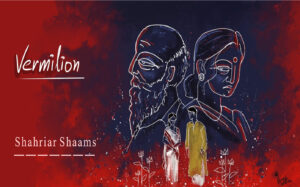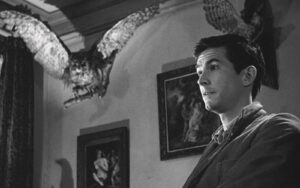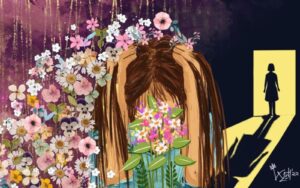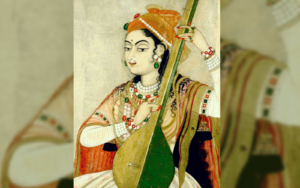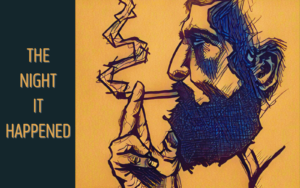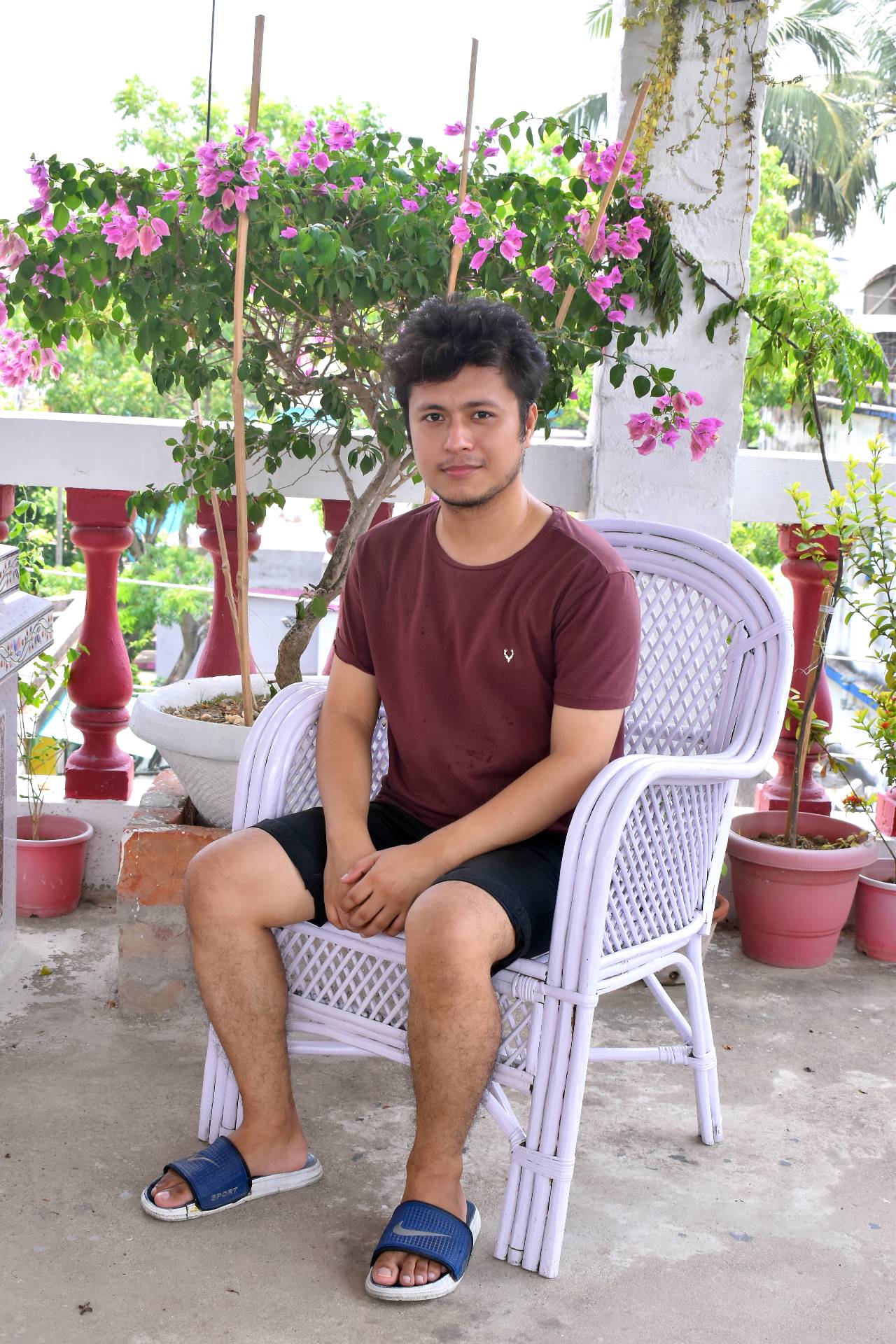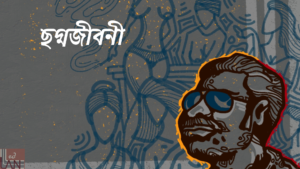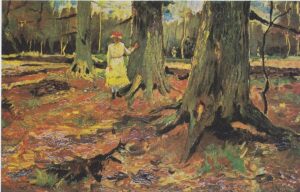LGBTQ+ literature and writing in India has witnessed a rapid proliferation in the past two decades; the Timeline of Indian Queer Literature in English that I had published online in 2021 attests to this exciting reality, and the trends in contemporary publication promise consistent growth in the future too. In tandem, discussions, discourses, and research in the field of queer and sexuality studies in Indian literary and academic networks have been steadily contributing to the growing field of Queer Studies in India, with some colleges and universities, like Jadavpur, Pune, Ashoka, etc., offering courses in this context. Given the dire implications of Section 377 of the Indian Penal Code (IPC) that indirectly criminalised homosexuality in India until very recently, investments in the study of the issues concerning LGTBQ+ individuals have been an important need of the hour and will continue to do so in the future, and literature, being an important cultural marker of change, plays a crucial role in the social conversations surrounding issues of the non-normative. In this short essay, I initiate a conversation on a very specific context of contemporary queer literature in India – gay romance; particularly, I look at the idea of queer love as being multivalent in its representation in queer Indian literary texts.
In differentiating between ‘passionate love’ and ‘romantic love’ in the context of the ‘West,’ Anthony Giddens claims that while “passionate love is a more or less universal phenomenon,” romantic love “is much more culturally specific.” However, the idea of romantic love as being specific to and as a product of European cultures has been challenged and revised by anthropologists who have interrogated the histories, constructs, and narratives of romantic love in both the West and the non-West in a near-‘universal’ framework. The lack that William R. Jankowiak and Edward F. Fischer have highlighted in their findings, with respect to the need for inter-culturally interrogating both the particular/specific and the universal/general in relation to one another, has since been revisited by some; critical works by Sudhir Kakar and John Munder Ross, Charles Lindholm and William M. Reddy are examples that focus on the need for culture-specific studies on/of romantic love and its cultures in non-Western contexts. But how does one study love and romance? How does one analyse something that evades analysis?
As anthropologist Charles Lindholm puts it, “scholarly reluctance to study love is connected to the way romantic love has been imagined to be a transcendent experience that, by its very nature, resists any rational analysis.” In fact, the problematic of dualism in both the qualitative scholarship on romantic love that reduces love to its singularly poetic or obscene/pornographic form and the discourse of quantitative, experimental science do injustice to the idea of romance and love itself. As such, psychoanalysts Sudhir Kakar and John Munder Ross question, “[h]ow dare we speak of worlds of love when all love and are loved so differently?” However, since “most of the discourses about love […] are to be found in literary sources,” it becomes viable and desirable to attempt studying love and romance and their cultures through an investment in ‘reading’ their literatures. Specifically, the love story emerges as a major generic vehicle in the literary understanding of love vis-à-vis the socio-politico-cultural. In Kakar and Ross’ ‘love theory,’ the love story features as the one that gives form to love through its “invocations and evocations.” Furthermore, it also can be considered that “the love story is the prime subverter of official mores […],” more so in terms of the non-heteronormative and queer, as a mirror to the realities (and fictions) of human relationships and as potential agents of re-fashioning socio-cultural understanding of love and romance.
Within this already ambiguous and multifaceted conceptual field, South Asia offers more challenges. Francesca Orsini, in mapping the cultural history of love in South Asia, emphasises upon the plurality of the ideas, practices, and cultures of love and romance in the Indian subcontinent – not as monoliths but as complex histories concerning both ‘affect’ and ‘sociality.’ When it comes to queerness and literature in India, Vanita and Kidwai’s now-iconic Same-Sex Love in India can be considered as one important example that has re-visited and re-vitalised traditions, histories, and narratives of same-sex desires and love in the Indian context, that have been otherwise neglected and sidelined by ‘normative’/’mainstream’ anthologies on love and romance. In its diversity of literary examples from the Sanskritic and the Perso-Urdu traditions of ancient and medieval India to the colonial and postcolonial modern, the anthology attempts at proselytising a progression of literature that implies a glorification of the rich history of narratives on same-sex love in India and converges with the cultural modernity of contemporary queer politics. Furthermore, their project of recording the movement, through time, of the various Indian same-sex love texts’ plural histories also entails in itself a progress towards a queer modernity – an alternative modernity that is on the one hand located in and localised by the traditions of the non-West sexuality discourse, and is on the other hand critical of West-centred terminologies that subscribe to a singular modernity model. For example, Vanita and Kidwai mention terms that “were in use in different languages at different times and places in India to refer to same-sex love” such as the word ‘chapti’ that denoted “sex between women as well as the women who practised it” in late medieval Urdu poetry, emphasising how it “predates any importation of nineteenth-century European psychologists’ terminology.”
Such a ‘queer’ anthology takes into consideration the sexual vis-à-vis the literary where the text itself functions on multiple levels and (to use Ruth Vanita’s own term) through “ever-shifting configurations;” I understand this as an example of the multivalence of sexual modernities. There is multiplicity in the idea of queer modernities in contemporary India, given the varied social, cultural, historical, political, linguistic, diversities that have their own bearings on how queerness is understood, lived, and represented today, in a post-377 era, making it imperative that we re-consider sexual modernity only in the plural. As such, in the context of studying the politics of sexualities in India, there is the need for interrogating the ways in which the Indian notions of sexualities are peculiar, ungeneralised, and multiplicitous, given the perceptions of existing traditions and colonial bias and competing notions and affects of modernisation and globalization that are often in confrontation with each other. Revisionary re-considerations of the sexual vis-à-vis the socio-cultural and politico-legal have also been attempted by critical projects that aim at positing the idea of multivalent queer modernities in some recent sociological, anthropological, and ethnographic analyses of LGBTQ+ lives, practices, and relations in India. Elsewhere, I have discussed how Indian queer modernities, reflected in several of the queer literary anthologies and critical texts, are both a development through Western sexual modernity and also a derivation from specific Indian contexts, showcasing a hybrid form of reclaiming queer sexualities.
With a similar understanding about a multivalent idea of non-heteronormative sexualities, there is a rising need to focus on and critically read and discuss the literature of love, romance, and the erotic. Elsewhere, I have discussed how queer and gay romance fiction has emerged as a phenomenon in the Indian literary scene in the recent past, and in the process, it has come to critique the existing and continued side-lining of queer sexuality and romance in/by the ‘mainstream’. In this context, I am interested in discussing ideas, aspirations, and re-presentations of romantic love by/in contemporary gay romance fiction that, according to me, is informed by an idea of multivalent sexual modernities in the literary cultures of love and romance in India, especially when considered in relation to, and distinct from, West-informed notions of modernity and romance. My use of the terms ‘queer loves’ and ‘gay romance’ is located within an understanding that contemporary gay romance fiction works within a discourse of multivalent (and alterative) sexual modernities. As such, I can assert that their contributions are invested with a politics of re-claiming, problematising, and diversifying the constructs of both ‘gay’ and ‘romance’ in contemporary literature.
The aforementioned constructs can be looked at through a discourse of location. If ‘gay’ can be considered to represent homosexuality in the Indian context, ‘pre-gay’ can be considered as representing a location of both non-access to the discourse of ‘gay’ and pre-existence of other forms of same-sex subjectivities; and ‘post-gay’ can be considered as representing a position marked by acceptance, performance, and refashioning of sexuality beyond the ‘gay.’ Similarly, if ‘queer’ is considered to represent a radical re-take on homosexuality, ‘pre-queer’ can be considered as representing a location of both non-arrival at the discourse of ‘queer’ and subscription to a compromise of non-non-normativity and non-disruption; and ‘post-queer’ can be considered as representing a position marked by a disruptive take on and politics of going beyond the ‘queer.’ In this context, Paul Boyce and Rohit K. Dasgupta’s ethnographic work on the idea of multiplicity in the modernities that contemporary non-heteronormative men occupy, perform, complicate, and aspire to can serve as an example of what I am proposing. They reveal that the interconnections among modernity, queer desires, and the Indian state render the queer subject as a project of Indian modernity. However, the use of none of these concepts can individually suffice in adequately understanding and revising how we perceive queer sexualities in the Indian contexts that are marked by multiple locations and discourses of sexual modernities. They need to be seen as overlapping and concurrent moments and considered simultaneously for arriving at a workable idea of what I term multivalent (and alterative) sexual modernities in India, specifically in the context of contemporary queer literature in India.
As such, the ‘gay,’ the ‘pre-gay,’ the ‘post-gay,’ the ‘queer,’ the ‘pre-queer,’ and the ‘post-queer’ concurrently co-exist and are constantly re-visited through their dialogic encounters and can, therefore, not be placed in hierarchies. Contemporary Indian gay romance fiction can be variedly situated in the locations of the ‘pre-,’ in the positions of the ‘post-,’ and in their correlations, thereby being constructive towards and informed by an idea of multivalent (and alterative) sexual modernities. As an example of this understanding, I consider gay romance novels as being variedly located and occupying various positions within a ‘spectrum’ of multivalent (and alterative) sexual modernities (see Fig. 1 below for a model spectrum of select contemporary Indian ‘gay romance’ fiction in English).
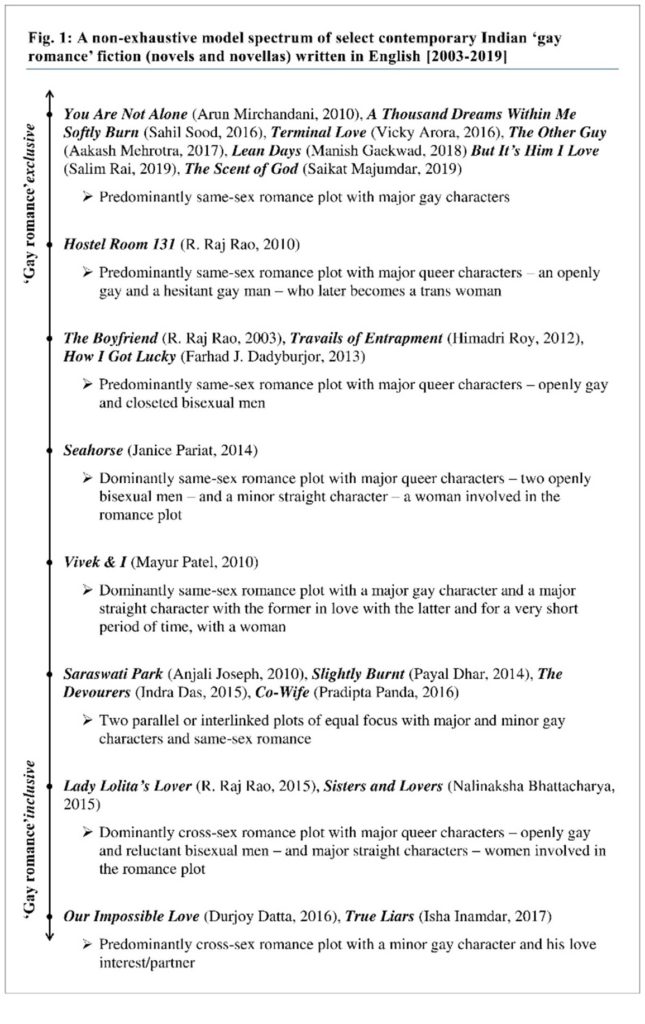
In this model spectrum, I use both the terms ‘exclusive’ and ‘inclusive’ in a positive manner. By ‘gay romance’ exclusive, I mean to denote those novels that exclusively focus on same-sex romance and relationships between men; complementarily, by ‘gay romance’ inclusive, I mean to denote those novels that include some form of same-sex romance and relationships between men in a positive manner. As such, the two opposing axes that inform and help locate the gay romance fiction in a spectrum of varied types of ‘queer plots also hint at an underlying politics of narrative plurality and diversifying heterogeneity in contemporary gay romance writing in India, as evident from the diversity in the non-heternormative plots of the texts located and positioned in a multivalent (and alterative) understanding of sexual modernities. In the context of the gay romance literature, for example, while the gay protagonists in Mehrotra’s The Other Guy are made to represent the experiences and aspirations of gay men by bringing then into focus, making the text itself as the queer lens, in a novel like Datta’s Our Impossible Love, the predominantly heterosexual readership is made to employ a queer lens in a way that makes them reconsider inclusivity in broader terms. I believe that the contrast in this example is not distinctive in categorisation but representative of the varied forms of queerness and non-normative sexual modernities that the country has witnessed over the decades, as reflected in the ways in which we perceive and converse about issues of non-normative sexualities and same-sex relations in the public domain.
The specific focus on the genre of the novel lies in the idea that the novel is dynamic, ever-changing, and discursively representative of socio-politico-cultural aspirations, more specifically so in the context of the contemporary in the literary and the historical. According to Georg Lukacs, the notion of creative subjectivity in the generic politics of the ‘novel’ form entails a fusion of varied, heterogeneous literary components into a whole which is then constantly revisited and reconsidered. Furthermore, according to the Bakhtinian theorisation of the status of the novel as “the only developing genre” and as one that can reformulate and re-accentuate other genres and help de-canonize genres and styles, writing in the ‘novel’ form can be understood to insert an indeterminacy and open-endedness that correlates to the evolving contemporary reality. In these theoretical contexts of the novel as a genre, the role of the ‘gay romance’ novel comes to occupy a crucial place in the analysis and the problematisation of socio-cultural contemporaneity vis-à-vis sexualities and their narratives – specifically in the context of LGBTQ+ literature and literary cultures – and by extension, the processes of canon-formation because of, but not limiting to, the agency of flux, of being constantly rethinking, rewriting, and retelling ‘queerer’ stories every time. As such, I believe, the ‘gay romance’ fiction in the form of the literary novel becomes an apt candidate for a chronotopic discourse on the dynamicity of/in socio-cultural realities and experiences located in the peculiar time-space nexus of the contemporary post-377 period in India, specifically when it comes to rethinking sexual modernities in a state of flux influenced by both the colonial past and the postcolonial present; this aspect of contemporary queer literature becomes especially important vis-à-vis non-(hetero)normative (and by virtue of it, challenging and transformative) contestations of the mainstream heteronorm in romance literature through inflections by/of multivalent (and alterative) sexual modernities in contemporary India.
Citations:
[1] Anthony Giddens, The Transformation of Intimacy: Sexuality, Love and Eroticism in Modern Societies (Stanford: Stanford University Press, 1992), 38.
[2] See William R. Jankowiak and Edward F. Fischer, “A Cross-Cultural Perspective on Romantic Love,” Ethnology 31, no. 2 (1992): 149—150, 154. Also see William M. Reddy, The Making of Romantic Love: Longing and Sexuality in Europe, South Asia, and Japan, 900–1200 CE (Chicago: University of Chicago Press, 2012), 2—5.
[3] See chapters 3, 4, 5, 7, and 8 of Sudhir Kakar and John Munder Ross, Tales of Love, Sex, and Danger, 2nd Ed. (New Delhi: Oxford University Press, 2011).
[4] See Charles Lindholm, “Love and Structure,” Theory, Culture and Society 15, no. 3-4 (1998): 249—257. .Also see Charles Lindholm, “Romantic Love and Anthropology,” Etnofoor 19, no. 1 (2006): 13—17.
[5] See chapters 4 & 5 of Reddy, Romantic Love.
[6] Lindholm, “Romantic Love,” 8.
[7] See Ibid., 9.
[8] Kakar and Ross, Tales, 4.
[9] Francesca Orsini, “Introduction,” in Love in South Asia: A Cultural History, ed. Francesca Orsini (New Delhi: Cambridge University Press, 2007), 2.
[10] Kakar and Ross, Tales, 175.
[11] Ibid., 8.
[12] Ross and Kakar’s psychoanalytical attempt at formulating a ‘phenomenology of passionate love’ is one such example of analysing love and romance in the academic discourse where they refer to the theories and views of the likes of Sigmund Freud, Jean-Paul Sartre, Roland Barthes, etc. to study and discuss the existing cultural-literary narratives, traditions, and constitutive dimensions of romantic eroticism and passionate love, desire, and longing in Indian contexts. See Kakar and Ross, Tales, 178—196.
[13] See Orsini, “Introduction,” 1.
[14] Ruth Vanita, “Introduction,” in Queering India: Same-Sex Love and Eroticism in Indian Culture and Society, ed. Ruth Vanita (New York: Routledge, 2002), 9.
[15] Brinda Bose and Subhabrata Bhattacharyya, “Introduction,” in The Phobic and the Erotic: The Politics of Sexualities in Contemporary India, ed. Brinda Bose and Subhabrata Bhattacharyya (Calcutta: Seagull Books, 2007), xii.
[16] Some relevant examples are Suparna Bhaskaran’s Made in India: Decolonizations, Queer Sexualities, Trans/national Projects (2004), Ruth Vanita’s Love’s Rite: Same-Sex Marriage in India and the West (2005), Parmesh Shahani’s Gay Bombay: Globalization, Love and (Be)longing in Contemporary India (2008), Naisargi N. Dave’s Queer Activism in India: A Story in the Anthropology of Ethics (2012), and akshay khanna’s Sexualness (2016).
[17] Anil Pradhan, “Towards a Post-Queer Modernity: The Reclamation of Same-Sex Literary Cultures of/in India.” Lapis Lazuli – An International Literary Journal 9, no. 1 (2019): 102.
[18] See Anil Pradhan, “Critiquing the (Hetero-)Canon of Love: Desire and Longing in Contemporary Indian ‘Gay Romance’ Fiction,” In Plainspeak: A Digital Magazine on Sexuality in the Global South 76, (2020).
[19] See Paul Boyce and Rohit K. Dasgupta, “Utopia or Elsewhere: Queer Modernities in Small Town West Bengal,” in Urban Utopias: Excess and Expulsion in Neoliberal South Asia, ed. Tereza Kuldova and Mathew A. Varghese (Basingtoke: Palgrave Macmillan, 2017), 215—219.
[20] Ibid., 223.
[21] Georg Lukacs, The Theory of The Novel: A Historico-Philosophical Essay on the Forms of Great Epic Literature, trans. Anna Bostock (London: The Merlin Press, 1971), 84.
[22] See ibid., 84—93.
[23] Mikhail Mikhailovich Bakhtin, The Dialogic Imagination: Four Essays, ed. Michael Holquist and trans. Caryl Emerson and Michael Holquist (Austin: University of Texas Press, 1981), 4.
[24] See Ibid., 5.
[25] Ibid., 6.
[26] Ibid., 7.
[27] I refer to Bakhtin’s idea of the ‘chronotope’ as ‘time space’ – the intrinsic connectedness of temporal and spatial relationships that are artistically expressed in literature.” See Ibid., 84—85.

